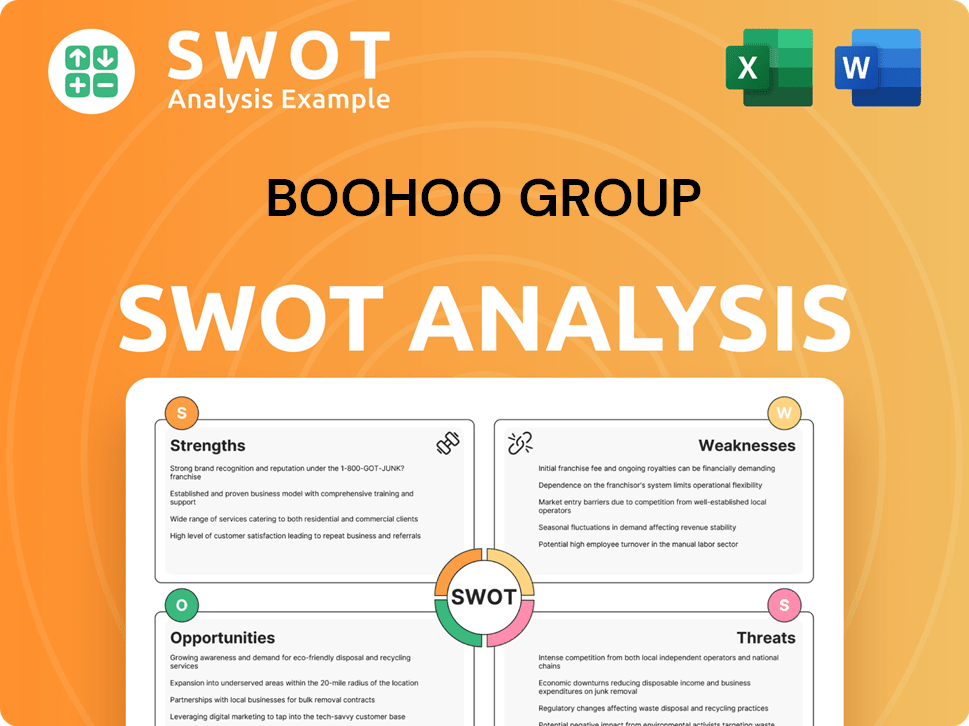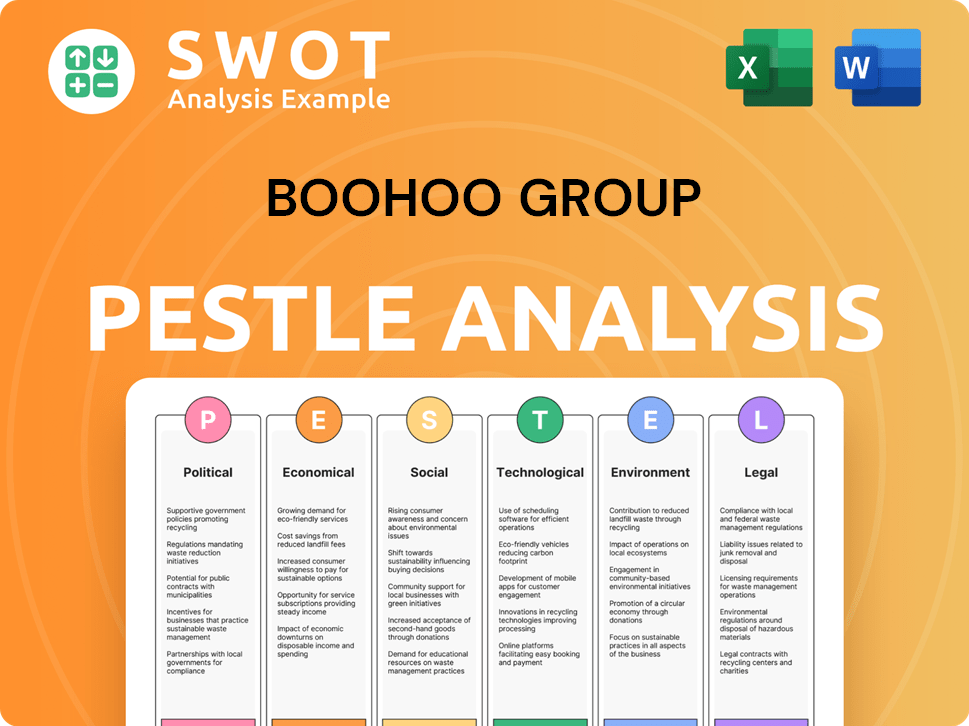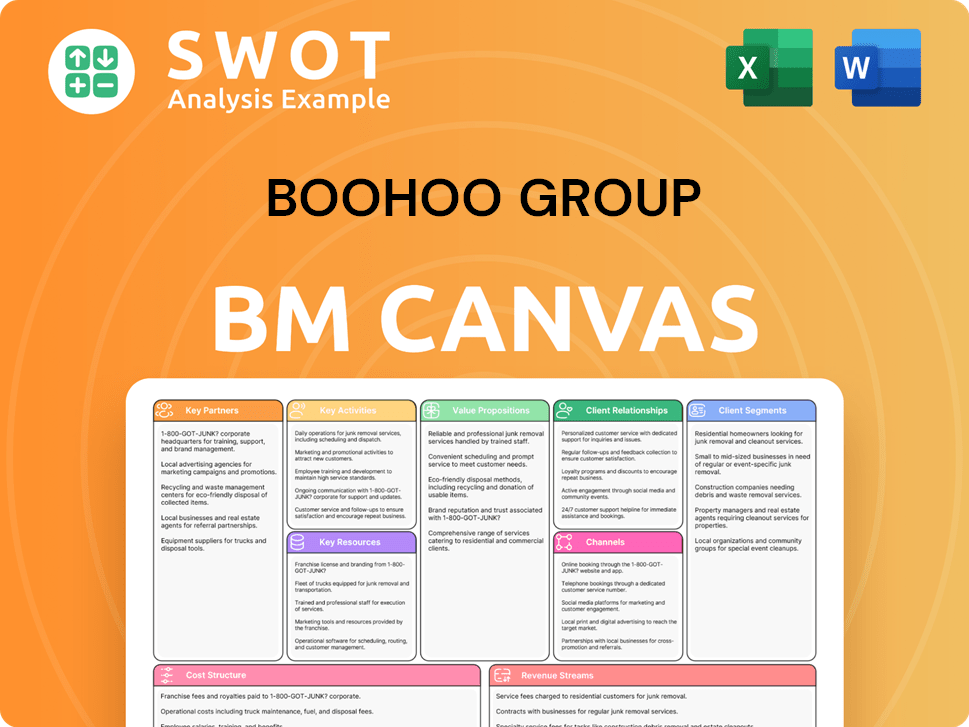boohoo group Bundle
How Does the boohoo group Thrive in the Fast Fashion World?
Boohoo Group PLC has become a global force in online fashion, captivating a young demographic with its trend-driven offerings. This success is built on a foundation of diverse brands like boohoo, PrettyLittleThing, and Nasty Gal, all contributing to its extensive product range. Understanding the inner workings of the boohoo group SWOT Analysis is key to grasping its market position and future potential.

The boohoo company's business model, emphasizing agility and digital prowess, enables rapid adaptation to fashion trends, translating them into affordable styles. This operational efficiency, combined with a global footprint, makes Boohoo a fascinating case study. We'll explore its core functions, revenue streams, and strategic evolution to provide a comprehensive view of this online retail giant and its approach to profitability.
What Are the Key Operations Driving boohoo group’s Success?
The core operations of the boohoo group are built around a vertically integrated, test-and-repeat business model. This model allows the company to quickly design, source, market, and sell fashion products. The value proposition focuses on offering a wide selection of trendy, affordable fashion items to its digitally native customer base. This approach has enabled boohoo to become a significant player in the fast-fashion industry.
The operational process begins with in-house design teams that identify emerging trends. A robust sourcing and manufacturing network, primarily in the UK and Asia, supports quick turnaround times. The company leverages technology for its e-commerce platforms, ensuring a seamless online shopping experience across its brands. Logistics and distribution are handled through strategically located warehouses, facilitating efficient global shipping. Sales are exclusively online, supported by digital marketing campaigns.
The agility of boohoo's supply chain is a key differentiator. This allows the company to introduce new products within weeks, significantly faster than traditional retailers. The 'test and repeat' model minimizes inventory risk by producing small batches of new styles. This capability provides customers with constant newness, affordability, and the ability to stay ahead of fashion trends, setting boohoo apart in the competitive fast-fashion market. The company's success is also reflected in its financial performance, with revenues and profits showing growth in recent years, despite challenges in the retail sector.
In-house design teams are at the forefront, constantly monitoring trends. They quickly identify emerging styles and translate them into designs. This fast-paced approach ensures that new collections are always aligned with current fashion preferences, keeping the brand relevant and appealing to its target audience.
A strong sourcing and manufacturing network is crucial for quick turnaround times. The company primarily uses suppliers in the UK and Asia. This network allows for efficient production and helps maintain competitive pricing, essential for the fast-fashion business model.
The company relies heavily on its e-commerce platforms for sales and customer interaction. Technology development ensures a seamless online shopping experience. This includes user-friendly interfaces, easy navigation, and efficient order processing, which are critical for customer satisfaction.
Strategically located warehouses support efficient global shipping. This setup allows for timely delivery to customers worldwide. Effective logistics are essential to meet customer expectations for fast and reliable delivery, which is a key aspect of the online retail experience.
The agility of the supply chain and the 'test and repeat' model are key. This allows for quick product launches and minimal inventory risk. This approach enables the company to adapt rapidly to changing fashion trends, ensuring a constant flow of new products. For more insights, you can read about the company's operations in this article about boohoo group.
- Rapid Product Introduction: New styles introduced within weeks.
- Inventory Risk Mitigation: Small batch production to minimize risk.
- Customer Benefits: Constant newness, affordability, and trend-setting styles.
- Digital Marketing: Aggressive digital marketing campaigns utilizing social media influencers and targeted advertising.
boohoo group SWOT Analysis
- Complete SWOT Breakdown
- Fully Customizable
- Editable in Excel & Word
- Professional Formatting
- Investor-Ready Format

How Does boohoo group Make Money?
The boohoo group generates revenue primarily through the direct sale of clothing, shoes, accessories, and beauty products across its various brands. This online retail giant focuses on a fast-fashion model, enabling it to quickly adapt to changing trends and customer preferences.
Product sales are the main source of income for the boohoo company. The company uses a strategy of high-volume sales at competitive prices. This approach is central to its business model, driving both customer acquisition and revenue growth.
For the financial year ending February 29, 2024, the boohoo group reported a revenue of £1,460.6 million, demonstrating its significant market presence and sales volume within the fast-fashion industry.
The boohoo business model employs several strategies to maximize revenue beyond direct sales. These include tiered pricing for different product lines and cross-selling opportunities across its brands. Promotional offers and seasonal sales also play a key role in driving sales and customer engagement.
- Tiered Pricing: boohoo uses different price points for various product lines, such as premium collections versus everyday essentials.
- Cross-Selling: Customers are exposed to products from different brands within the boohoo group, encouraging larger purchases. For example, customers browsing on PrettyLittleThing might see beauty products available on the boohoo site.
- Promotional Offers and Sales: The company frequently uses promotional offers and seasonal sales events to attract customers and boost conversion rates.
- Product Category Expansion: boohoo has consistently expanded its product categories, including activewear and beauty, to diversify its offerings and capture a larger share of its target market's spending.
boohoo group PESTLE Analysis
- Covers All 6 PESTLE Categories
- No Research Needed – Save Hours of Work
- Built by Experts, Trusted by Consultants
- Instant Download, Ready to Use
- 100% Editable, Fully Customizable

Which Strategic Decisions Have Shaped boohoo group’s Business Model?
The boohoo group has achieved significant milestones that have shaped its trajectory within the fast-fashion industry. A key strategic move was its aggressive acquisition strategy, which incorporated brands like PrettyLittleThing and Nasty Gal, expanding its market reach and diversifying its brand portfolio. These acquisitions have been instrumental in driving revenue growth, with PrettyLittleThing often outperforming the core brand.
The boohoo company has navigated operational and market challenges, including scrutiny over its supply chain and the impact of economic pressures on consumer spending. In response, the company has focused on improving ethical sourcing and supply chain transparency. To mitigate inflationary pressures, boohoo has optimized inventory management and operational efficiencies. The boohoo business model is built on agility and rapid trend adoption.
boohoo's competitive advantages stem from its agile business model, allowing for quick trend adoption and minimized inventory risk. Its strong brand recognition among its target demographic, coupled with effective digital marketing, reinforces its market position. Furthermore, its economies of scale, particularly in sourcing and logistics, provide a cost advantage. The company continues to adapt by constantly refreshing its product offerings and leveraging social media to engage with its youthful customer base.
boohoo's success is underpinned by strategic acquisitions and a focus on operational efficiency. The company's ability to quickly adapt to fashion trends and leverage digital marketing is a key competitive advantage. Addressing supply chain concerns and managing economic pressures are ongoing priorities.
- Acquisitions: The acquisition of brands like PrettyLittleThing has significantly expanded boohoo's market presence and revenue.
- Supply Chain: boohoo has invested in improving ethical sourcing and supply chain transparency.
- Digital Marketing: Effective use of social media and online platforms to engage with customers.
- Operational Efficiency: Focus on optimizing inventory management and operational efficiencies to mitigate inflationary pressures.
boohoo group Business Model Canvas
- Complete 9-Block Business Model Canvas
- Effortlessly Communicate Your Business Strategy
- Investor-Ready BMC Format
- 100% Editable and Customizable
- Clear and Structured Layout

How Is boohoo group Positioning Itself for Continued Success?
The boohoo group holds a significant position in the online fast fashion market, competing with major players like ASOS and Shein. Its multi-brand approach caters to a wide range of customers. The company's ability to quickly introduce new products and maintain a strong social media presence helps to build customer loyalty. The boohoo company also has a global reach, serving customers in numerous countries.
The boohoo business model faces several challenges, including intense competition from other fast-fashion retailers. It must also navigate potential regulatory changes related to labor practices and sustainability, along with fluctuations in consumer spending. Supply chain disruptions, as experienced during the pandemic, pose an ongoing risk. Looking ahead, the company is focused on strategic initiatives to drive sustainable growth, including investments in technology, supply chain optimization, and expansion into new markets.
The boohoo group operates within the competitive online retail market, specializing in fast fashion. The company's success hinges on its ability to quickly adapt to changing trends and consumer preferences. Its multi-brand strategy allows it to target diverse customer segments.
Key risks include intense competition, potential regulatory changes, and economic fluctuations. Supply chain disruptions and the need for ethical sourcing practices also pose challenges. The company must continually innovate to stay ahead.
The boohoo company aims to achieve sustainable growth through technological advancements and supply chain improvements. Expansion into new product categories and markets is also a priority. The focus remains on profitability and operational excellence.
Strategic initiatives include investing in its technology platform, optimizing its supply chain, and expanding into new markets. The company is dedicated to offering trend-led fashion at competitive prices. Operational resilience and brand portfolio strengthening are also key.
The boohoo group is focused on driving sustainable growth through various strategic initiatives. These include investments in technology, supply chain optimization, and expansion into new product categories or geographic markets. The company is committed to profitability and cash generation.
- Continued investment in its proprietary technology platform for enhanced efficiency.
- Optimizing the supply chain for greater efficiency and ethical compliance, which is crucial for the boohoo fashion brand's reputation.
- Expanding into new product categories and geographic markets.
- Focus on profitability and cash generation, signaling a focus on operational excellence.
- Offering trend-led fashion at competitive prices. For more insights into the company's strategic direction, check out Growth Strategy of boohoo group.
boohoo group Porter's Five Forces Analysis
- Covers All 5 Competitive Forces in Detail
- Structured for Consultants, Students, and Founders
- 100% Editable in Microsoft Word & Excel
- Instant Digital Download – Use Immediately
- Compatible with Mac & PC – Fully Unlocked

Related Blogs
- What are Mission Vision & Core Values of boohoo group Company?
- What is Competitive Landscape of boohoo group Company?
- What is Growth Strategy and Future Prospects of boohoo group Company?
- What is Sales and Marketing Strategy of boohoo group Company?
- What is Brief History of boohoo group Company?
- Who Owns boohoo group Company?
- What is Customer Demographics and Target Market of boohoo group Company?
Disclaimer
All information, articles, and product details provided on this website are for general informational and educational purposes only. We do not claim any ownership over, nor do we intend to infringe upon, any trademarks, copyrights, logos, brand names, or other intellectual property mentioned or depicted on this site. Such intellectual property remains the property of its respective owners, and any references here are made solely for identification or informational purposes, without implying any affiliation, endorsement, or partnership.
We make no representations or warranties, express or implied, regarding the accuracy, completeness, or suitability of any content or products presented. Nothing on this website should be construed as legal, tax, investment, financial, medical, or other professional advice. In addition, no part of this site—including articles or product references—constitutes a solicitation, recommendation, endorsement, advertisement, or offer to buy or sell any securities, franchises, or other financial instruments, particularly in jurisdictions where such activity would be unlawful.
All content is of a general nature and may not address the specific circumstances of any individual or entity. It is not a substitute for professional advice or services. Any actions you take based on the information provided here are strictly at your own risk. You accept full responsibility for any decisions or outcomes arising from your use of this website and agree to release us from any liability in connection with your use of, or reliance upon, the content or products found herein.